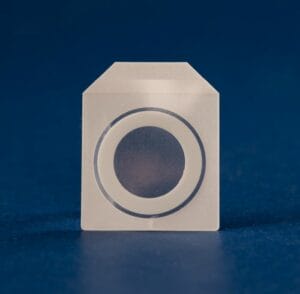
The Viaskin patch for peanut allergy is showing promise in desensitizing peanut-allergic toddlers in a late-stage trial.
After wearing the patch for a year, 67 percent of peanut-allergic children ages 1 to 3 were able to eat up to 1,000 milligrams (mg) of peanut – about three to four peanuts – before starting to react. The findings were published in the New England Journal of Medicine.
The Viaskin patch, made by DBV Technologies, contains a small dose of peanut protein. Worn daily, the patch sticks to the skin between the shoulder blades. This allows the protein to be absorbed through the skin.
The patch therapy’s goal is desensitization, or increasing the threshold for how much peanut a child can consume before experiencing allergy symptoms. This safety buffer can help protect from serious reactions due to accidental peanut exposures.
The patch “could one day fulfill a huge unmet medical need,” says allergist Dr. Matthew Greenhawt, lead author of the study. Peanut allergy is commonly diagnosed early in life, and fewer than 29 percent outgrow peanut allergy by age 6, he says.
Greenhawt, a professor of pediatrics at the University of Colorado School of Medicine, points to a benefit for families if the Viaskin patch gets approved for kids ages 1 to 3. “They could start this promptly after diagnosis, narrowing the time they live without having an active option to treat peanut allergy,” he says.
Currently, there is only one Food and Drug Administration-approved desensitization treatment for peanut allergy, Palforzia. Palforzia is a peanut protein powder oral immunotherapy for children 4 to 17. If approved in the young age group, Viaskin would become the first peanut allergy treatment that didn’t require food consumption.
Viaskin Patch: Study Results
In the Phase 3 trial, called EPITOPE, researchers randomly assigned 362 toddlers to receive either the patch containing about 1/1,000th of a peanut kernel, or a placebo patch.
To qualify for the trial, children had to react to 300 mg or less of peanut in a double blind, placebo-controlled food challenge.

Initially, 81 percent of the kids in the study reacted to between 30 and 300 mg of peanut protein. There was also a small group of highly reactive kids who reacted to 10 mg or less of peanut protein.
After one year, to be considered “responders,” children who initially reacted to 10 mg of peanut or had to consume 300 mg without a reaction. That’s about 1 peanut.
Kids who could eat more peanut at the start of the study had to get to 1,000 mg before starting to react, Greenhawt says. That’s the equivalent of 3 to 4 peanuts.
About 67 percent met either of these desensitization goals, compared to 33.5 percent on the placebo patch. “It was a tremendous effect,” says Dr. Pharis Mohideen, DBV Technologies chief medical officer.
He notes that the most sensitive group’s response is important, too. “You are going from a child who is exquisitely sensitive to a small amount of peanut protein, to one who can tolerate a full peanut kernel.”
Patch and Toddlers: Were There Reactions?
Few dropped out because of side effects. During the trial, most reactions were local skin reactions at the patch application site. Four toddlers experienced anaphylaxis related to the treatment, though none were severe. Three of these reactions resolved with one dose of epinephrine and the fourth resolved without the drug.
Another potential benefit of the patch: kids wear it 24/7, including during exercise and when they are ill. That’s different from oral immunotherapy (OIT), in which kids eat increasing amounts of peanut over the course of several months to help desensitize them.
In OIT, it’s common for doctors to recommend up to a two-hour rest period after their daily dose, and to advise skipping or adjusting a dose when a child is ill.
With the patch, “the child’s activities do not need to be adjusted around the dose, and can even be applied when the child is ill,” Greenhawt says.
Next Steps for Viaskin Patch
The FDA has asked the company for additional safety data, to bring the total number of toddlers treated with the Viaskin patch to 600. Enrollment in that trial should start in fall 2023. Peanut-allergic participants in that study will not need to do a food challenge, Mohideen notes.
The company is also conducting a three-year extension trial to see if desensitization continues to improve with longer wear. In this phase, all kids in the trial, including those initially on the placebo patch, will receive the patch containing the actual peanut protein.
Viaskin: Moving Through Challenges
DBV Technologies has faced hurdles with the Viaskin experimental patch. While the new study in toddlers shows much promise, some clinical trial results have been disappointing. In 2017, a trial in kids 4 to 11 failed to meet FDA statistical endpoints after one year of patch wearing.
Subsequent trials, however, showed that the patch was more effective when worn for longer, and also seems to work best in younger kids. “Growing evidence from early introduction studies suggests that the allergic immune system is more modifiable early in life,” Greenhawt says.
In 2020, the company published data showing that after three of years of using the patch, 52 percent of children ages 4 to 11 could consume up to 1,000 milligrams of peanut before starting to react.
But the company faced yet another setback in 2020, when the FDA raised concerns about the Viaskin patch’s adhesion to the skin, and turned down the company’s application for approval in kids 4 to 11.
In response to FDA concerns, DBV modified the patch, including making it a bit smaller, and is currently studying the new patch in kids 4 to 7. (This latest trial in kids ages 1 to 3 uses the original patch.)
Comparing with OIT
Dr. Alkis Togias, chief of the National Institute of Allergy and Infectious Diseases’ allergy and asthma branch, calls the EPITOPE trial results “very good news” for toddlers with peanut allergy and their families.
In an editorial accompanying the study’s publication, he compared the results of the Viaskin patch to a trial of peanut OIT in children of a similar age. He noted that OIT resulted in more kids able to safely consume higher amounts of peanut than the Viaskin trial.
The OIT trial, called IMPACT, found that 71 percent of children in the group receiving OIT could consume 5 grams of peanut (16 to 20 peanuts) without an allergic reaction, compared to 2 percent given placebo. But more kids on the OIT peanut flour regimen needed epinephrine to treat reactions than during the Viaskin patch trial.
This is why options are so important, Mohideen says. “As the father of two children, who both have nut allergies, to go from reacting at 10 mg to being able to eat 300 mg is life-changing,” he says. “It opens up so many doors. It’s exactly what the product is about. Giving people options, and safety and peace of mind for the parents and the children.”
Related Reading:
Allergists See Palforzia Starting New Era of Food Allergy Therapy
Could Xolair Be the First Biologic Treatment for Food Allergies?





